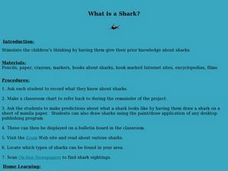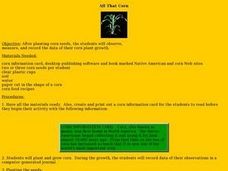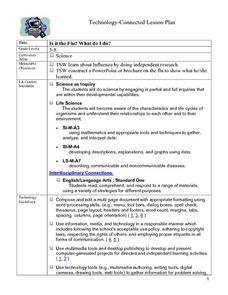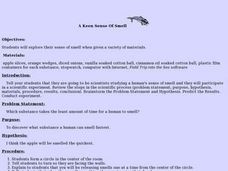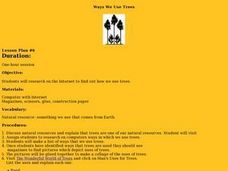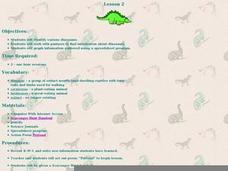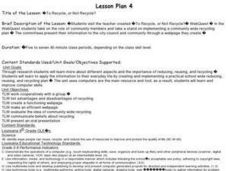Curated OER
Travel Brochure
Use the Internet to find facts about the planets. Cooperative groups design a travel brochure for a planet. They use a desktop publishing program to create the travel brochure.
Alabama Learning Exchange
Light, Dry and Nutritious - A Look at Dehydrated Food
Fifth graders study dehydration and dehydration of foods. They measure the amount of water lost from fruits as they are dehydrated. They use desktop publishing software to design an advertisement for dehydrated fruit after researching...
Curated OER
The Froggy Page
Students investigate the cycle of life by observing tadpoles. In this biology lesson plan, students utilize the Internet to read stories, observe pictures, and listen to sounds of frogs. Students create a poster board collage...
Curated OER
Basic Knowledge of Big Cats
First graders create a KWL chart on big cats. In this animal science lesson plan, 1st graders brainstorm what they already know about big cats and research big cats using various suggested websites. Students fill in the last column of...
Curated OER
Big Cat Classification
First graders discover the different names and classifications of big cats by using word processing applications. In this animal life lesson, 1st graders investigate one big cat and create a database of facts about it using an word...
Alabama Learning Exchange
Weather Instruments For Sale
Learners create advertisements for a weather instrument. They conduct Internet research, write a descriptive and persuasive advertisement for the instrument using the flyer template of desktop publishing software, and print a copy that...
Curated OER
Photosynthesis and Cell Respiration
Fifth graders participate in scientific inquires regarding the concepts of photosynthesis and cell respiration. In this photosynthesis and cell respiration lesson, 5th graders describe the process of photosynthesis with relation to...
Curated OER
Comparing Mitosis with Meiosis
Life science learners view an online animated mini textbook comparing two types of cell division. Working in groups, they use a digital microscope to capture images of cells in different stages of mitosis and meiosis. Then they create an...
Curated OER
Camouflage
First graders learn how plants and animals adapt to their environments. In this camouflage lesson plan, 1st graders watch a movie that explains animal camouflage, design a butterfly that blends into a classroom habitat, create a...
Curated OER
Where Do We Live?
Second graders investigate various types of habitats. In this habitat exploration lesson, 2nd graders view a PowerPoint presentation on habitats and explore websites to gather more information. Students choose a habitat to focus on and...
Curated OER
What is a Shark?
Students discuss their knowledge of sharks. In this shark instructional activity, students read about various sharks and look up shark sightings in an online newspaper. They create Shark-shaped poetry.
Curated OER
Make a Model of a Tree
Students identify the parts of a tree. In this tree biology activity, students create a tree model using tree parts and drawing the roots. Students label each part of the tree and maintain a tree journal during this unit.
Curated OER
All That Corn
Students observe and record data. In this plant growth lesson, students plant and grow corn. Students observe the growth of their corn and record their data. Students read corn recipes and select their favorite four...
Curated OER
"Drug Abuse Brochure"
Students understand the facts about drugs and what can also impact the whole school population. In this drug information lesson students complete research on the Internet and a drug abuse crossword handout.
Curated OER
Big Cats Sounds
Students explore the sounds of big cats. In this animal science instructional activity, students listen to the sounds of the big cats, such as lions and tiger, on a suggested website. Students research how the big cats use their sounds...
Curated OER
Beyond the Earth Part II
Students explore the solar system. In this solar system lesson, students use Internet and print resources to research a component of the solar system. Students create travel brochures based on their research findings.
Curated OER
Beyond The Earth Part I
Students explore the solar system. In this space science lesson, students take notes on the solar system provided by their instructors. Students then collaborate to design a computer-generated drawing of the solar system.
Curated OER
Is It The Flu? What Do I Do?
Students use the internet to research the flu. Using various websites, they identify who should get flu shots, how to protect themselves and guidelines for getting over the flu. They write a one page report on their findings to end the...
Curated OER
A Keen Sense of Smell
Learners investigate their sense of smell by experimenting with smelly objects. In this human senses lesson plan, students examine the length of time it takes to smell a random object that is close to them. Learners record...
Curated OER
Ways We Use Trees
Young scholars use the Internet to find the ways we use trees. In this tree instructional activity, students make a list of the uses of trees and find magazine pictures that show these uses to make a collage. They read The Giving Tree...
Curated OER
What's the Matter?
Students investigate matter. In this matter lesson, students identify types of matter and characteristics of each type. Students discuss matter and create matter posters to show understanding.
Curated OER
Dinosaur Scavenger Hunt
Young scholars conduct research on dinosaurs and graph the information gathered using a spreadsheet program. In pairs they complete an Internet scavenger hunt, and record five facts about dinosaurs in their science journal.
Curated OER
To Recycle, or Not Recycle?
To recycle or not to recycle, that is the question. Your class can find the answer by taking a teacher created WebQuest, where they assume a role of a community member taking a stand on implementing a community wide recycling plan. The...
Curated OER
Coastal Weather Issues: Planning for a Hurricane
Seventh graders utilize internet resources to gather, analyze, and interpret hurricane data. They develop a public information booklet that be used as a guide for the community to use when preparing for a hurricane.









